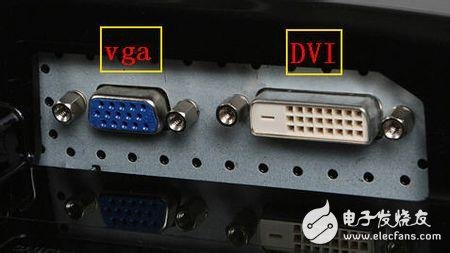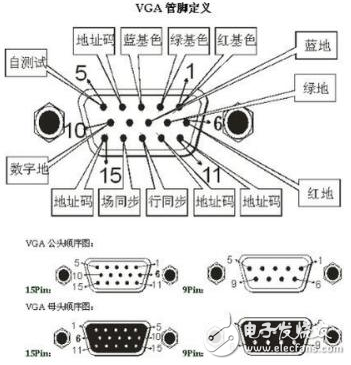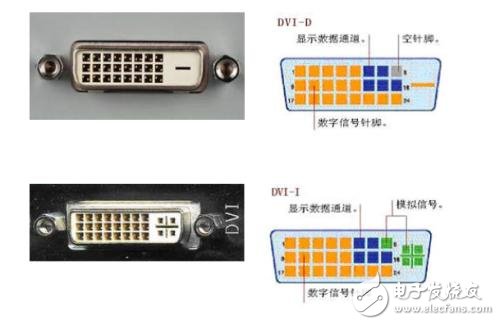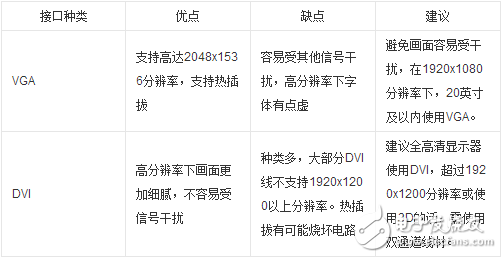The VGA interface and the DVI interface are two common interfaces on the display. What do they do? What are the differences between them? Which is better? VGA (VideoGraphicsArray) video graphics array is a computer display standard that IBM proposed in 1987 using analog signals. The VGA interface is a dedicated interface for the computer to use VGA standard output data. The VGA interface has a total of 15 pins, divided into 3 rows, 5 holes per row, and the most widely used interface type on the graphics card. Most graphics cards have such interfaces. It transmits red, green, and blue analog signals as well as synchronization signals (horizontal and vertical signals). VGA is a video interface with a pin count of 15, three rows of holes, five per row, mainly used for old-fashioned computer output, which is the specification for the early launch of Zui in three interfaces. The VGA output and the transmitted analog signal. Everyone knows that computer graphics cards produce digital signals, and displays use digital signals. So using a VGA video interface is equivalent to undergoing a digital-to-analog conversion and a single-modulo conversion. Signal loss, the display is more blurred. DVI (DigitalVisualInterface), which is a digital video interface. It was the interface standard introduced by DDWG (Digital Display Working Group) in 1999 by SiliconImage, Intel (Intel), Compaq (Compaq), IBM, HP (HP), NEC, Fujitsu (Fujitsu) and other companies. The DVI interface transmits digital signals that can transmit large resolution video signals. DVI is connected to the computer graphics card and display without conversion, so there is no loss of signal. DVI is based on TMDS (TransiTIonMinimizedDifferentTIalSignaling), which converts the minimum differential signal technology to transmit digital signals. TMDS uses advanced coding algorithms to encode 8-bit data (each of the primary color signals in R, G, and B) into 10-bit data by minimum conversion (including lines). Field synchronization information, clock information, data DE, error correction, etc., after DC balance, using differential signal transmission data, it has better electromagnetic compatibility than LVDS, TTL, can be realized with low-cost dedicated cable Distance, high quality digital signal transmission. The connection transmission structure of TMDS technology is shown in Figure 1. Digital Video Interface (DVI) is an internationally open interface standard that is used in a wide range of applications including PCs, DVDs, HDTVs, and high-definition projectors. 1, VGA interface appearance 15 pin, DVI interface appearance is a 24-pin connector; 2. The VGA interface transmits analog signals, and the DVI interface transmits digital signals; 3, VGA interface transmission to the display to undergo a digital-to-analog conversion and a single analog-to-digital conversion, signal loss, display is more fuzzy, and DVI connected to the computer graphics card and display without conversion, no loss of signal; 4, VGA interface transmission because it has to undergo two signal conversion, the speed is slow, the transmission is not stable, and DVI transmission does not require signal conversion, the speed is faster, the transmission is more stable; 5, VGA interface in the 800 & TImes; 600 resolution and DVI interface display effect is almost no difference, but the general analog signal in the case of more than 1280&TImes; 1024 resolution or more will appear obvious error, the higher the resolution is more serious. VGA is the most commonly used video input and output interface, carrying analog signals, DVI is a popular high-definition input and output interface, carrying digital signals. After the above comparison, DVI is more advanced than VGA. Because the digital signal is transmitted, the stability during transmission is good, and the deviation of color, brightness and contrast does not occur. The display of VGA interface is prone to color cast after long-term use. Image correction is often used. DVI supports higher resolution than VGA. DVI is more competitive than VGA in today's ever-increasing traffic.
Microsoft Surface charger have 4 types. For Surface Pro 1/2/3/4.
Surface Pro 1/2: 12V 3.6A
Surface Pro 3: 12V 2.58A
Surface Pro 4: 15V 1.6A
Microsoft charger has different connector with other Laptop Adapter. Its connector is magnetic tip.
Definitely Charge Faster, excellent power supply for Microsoft Surface Pro. Just drop it in your bag or even pocket and get going – no need to carry anything else, as power is always within easy reach.
Microsoft Surface Charger,Microsoft Surface RT Charger,Microsoft Surface Tablet Charger,Charger For Microsoft Surface Shenzhen Waweis Technology Co., Ltd. , https://www.waweis.com


